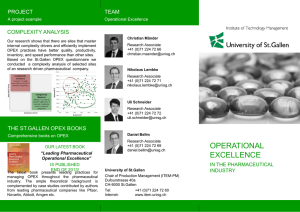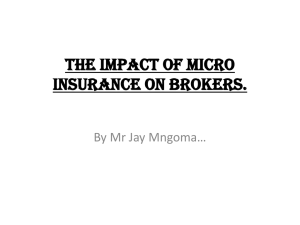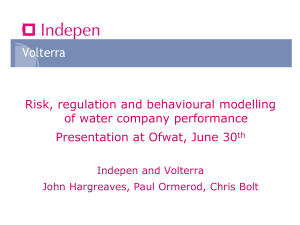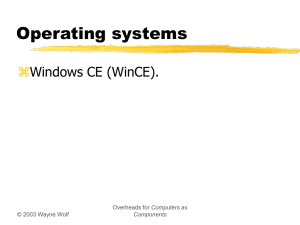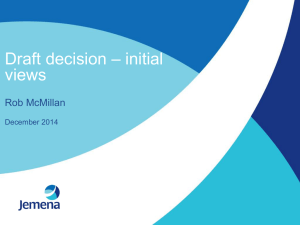Overheads, cost allocation, statuatory accounting, and capitalisation
advertisement
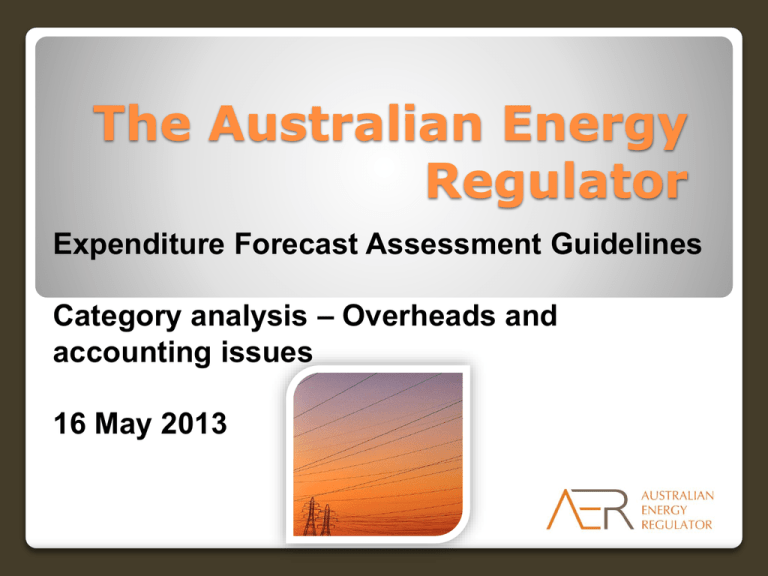
The Australian Energy Regulator Expenditure Forecast Assessment Guidelines Category analysis – Overheads and accounting issues 16 May 2013 Agenda 9:00 9:15 9:30 10:30 10:45 12:15 - Introductions and objectives Context and framework considerations Overheads Break Accounting issues Summary & next steps 2 Where are we today? 20 Dec 2012 • Issues paper 12 Feb 2013 • Initial Roundtable 28 Feb 2013 • Category selection 7/8 Mar 2013 19/20 Mar 2013 • Replacement/Demand • Connection/Customer driven capex 27 Mar 2013 • Repex/Augex models, demand forecasting 11 Apr 2013 • Opex category assessment 8 May 2013 • Base-step-trend/Productivity change 16 May 2013 TBC (~mid June) • Overheads, Cost allocation and accounting • Expenditure setting process 3 Objectives for today Provide context for overheads assessment Test potential assessment methods and data requirements: ◦ Expenditure categorisations ◦ Normalisations ◦ cost drivers Explore cost comparability issues: ◦ Cost allocation ◦ Capitalisation ◦ Other NSP reporting inconsistencies 4 Context for today Overheads, accounting and the incentive framework: ◦ Opex (including overheads) may be set using revealed cost ◦ Consistency in ex post/ ex ante capex assessments Dealing with changes to capitalisation policies Reporting of related party margins AER will compare overhead costs anyway: ◦ Opex activities in benchmarking reports ◦ Benchmarking of capex (including overheads) ◦ Capex/ opex category trade-offs 5 Overheads expenditures 6 Overheads – what’s in/ out “Overheads” = anything not yet covered in workshops “direct” overheads ◦ functions that are focussed on the management and general operation of the network ◦ e.g. Network planning and operations “Indirect” overheads ◦ corporate functions that are standard to almost all large businesses ◦ e.g. CEO, HR, licence fees Non-system capex, capitalised overheads 7 repex augex Non-system connections IT, comms opex Land and Buildings Indirect/ Corporate Vehicles Indirect/ corporate Capitalised overheads Allocated overheads CEO/ finance/ HR Direct overheads Licence fees Billing, customer interface Network planning & management direct operations Veg mgt maintenance emergency Expenditure capex Direct/ system 8 Opex breakdown, all NSPs 3% "direct" opex (repairs, maintenance) network operating costs 28% 55% 14% Source: Latest RIN data other opex (metering, customer service) opex overheads (where listed) 9 Capex breakdown, all NSPs system capex 4% 89% 11% 1% 2% IT Systems and communications Land Buildings 2% 2% vehicles other Source: Latest RIN data 10 Previous AER approaches In opex trends, recognition of: ◦ Correlation to network growth ◦ economies of scale/ presence of fixed costs Detailed expert review NSP justifications ◦ bottom up e.g. CBA ◦ non-bottom up/ modelling Some benchmarking (e.g. NSW reset) Limited consistency and transparency in reported categories 11 Ofgem’s general approach Direct overheads = “closely associated indirects” ◦ 11 sub-categories, eg network design, project management, control, call centre, training ◦ Grouped according to normalisation “metrics” MEAV Total network investment Total direct costs Drivers for the associated direct cost Combination of the above 12 Ofgem’s general approach Corporate / Indirect overheads = “business support costs” Eg HR, CEO, Finance, Property ◦ External benchmarking (ie with other, unregulated businesses) ◦ NSPs to provide evidence of insourcing/ outsourcing decisions/ business models ◦ Metrics (not drivers) – employee numbers, revenue, end users (eg IT clients) ◦ Expert review – IT and land 13 Ofgem’s general approach Boundary issues in direct vs indirect Treatment of once-off costs, use of averages for lumpy costs Benchmarking before and after allocations, to services as well as DNOs in a group Choice of metrics & transparency of assessment ◦ Use of (direct) expenditures as a driver/ metric potentially rewards inefficient behaviour ◦ “Metrics/ scale factors should be stable over time, outside the DNO’s control, not collinear with other measures” 14 Direct overheads (opex) Potential categorisations: ◦ Asset/Network Management ◦ Network operations ◦ “other” - Customer service, metering, billing? Potential drivers - network size/ value? ◦ Undepreciated RAB/ MEAV ◦ Revenue ◦ Customer numbers Impact of any “uncontrollable” factors as per direct capex/opex? 15 network ops 45000 40000 35000 30000 25000 20000 15000 10000 5000 0 1 2 3 4 5 6 7 8 9 10 11 12 13 14 15 16 17 16 network ops per RAB 10,000,000 9,000,000 y = 88.398x + 2E+06 R² = 0.1793 8,000,000 7,000,000 6,000,000 5,000,000 4,000,000 3,000,000 2,000,000 1,000,000 0 0 10000 20000 30000 40000 50000 60000 17 network ops per MEAV 60,000 50,000 y = 0.7476x - 3859.1 R² = 0.4987 40,000 30,000 20,000 10,000 0 0 10000 20000 30000 40000 50000 -10,000 18 "other" opex per customer numbers 1800000 1600000 1400000 1200000 y = 0.6905x + 656762 R² = 0.0083 1000000 800000 600000 400000 200000 0 0 50000 100000 150000 200000 19 "other" opex per revenue 2,000,000 1,800,000 y = 7.471x + 255940 R² = 0.632 1,600,000 1,400,000 1,200,000 1,000,000 800,000 600,000 400,000 200,000 0 0 50000 100000 150000 200000 20 Non-system capex Potential high level categories: ◦ ◦ ◦ ◦ ◦ ◦ ◦ IT Communications Vehicles Land Buildings Furniture, plant and equipment Other Drivers - network size, employees? Isolating recurrent from irregular costs 21 Non-system capex IT – subcategories and supporting data: ◦ ◦ ◦ ◦ recurrent vs one-off Leased vs purchased Fixed vs variable Cost per end user or employee? Communications - similar points to IT ◦ Hardware vs software ◦ Data vs oral communications ◦ Cost per end user or employee? 22 IT & comms (5 year average) per customer 0.3 0.25 0.2 0.15 0.1 0.05 0 1 2 Source: NSP RIN data 3 4 5 6 7 8 9 10 11 12 13 14 23 Non-system capex Vehicles – subcategories and supporting data: ◦ Leased vs purchased ◦ Cost and number of vehicles for: Heavy/ light Passenger/ commercial ◦ Impact of network area, km of line, employees, direct capex/ opex “workload”, number of jobs? ◦ Utilisation data – kms, days used? 24 Vehicles (5 year average) per km of line 6 5 4 3 2 1 0 1 2 3 4 5 6 7 8 25 Vehicles per total capex (5 year averages) 0.1 0.09 0.08 0.07 0.06 0.05 0.04 0.03 0.02 0.01 0 1 2 3 4 5 6 7 8 9 10 11 12 13 14 15 16 17 18 19 26 Indirect overheads Typical inclusions: CEO, Legal and secretariat, HR, Finance, Treasury Not visible in existing reporting Expect these costs to be largely fixed, otherwise by FTEs? May reflect uncontrollable jurisdictional/ regulatory differences Comparable with competitive firms? Expensed and capitalised Cost allocation issues 27 100% 90% 80% 70% 60% 50% % direct opex 40% % opex overheads 30% 20% 10% 0% 1 2 3 4 5 6 100% 7 90% 8 80% 70% 60% 50% % direct capex 40% % capex overheads 30% 20% 10% 28 0% 1 2 3 4 5 6 7 8 Accounting & reporting issues 29 “Accounting issues” Things which detract from like-for-like comparisons ◦ ◦ ◦ ◦ ◦ ◦ Capitalisation CAMs and cost allocation Related party margins/ fees Service classifications Standard voltage differences Different reporting years (calendar vs financial) 30 Capitalisation What’s the problem? ◦ Accounting rules/ discretion in expensing/ capitalising ◦ Policy not currently disclosed/explained by NSPs ◦ Lack of comparability, e.g. in capitalised labour, overheads What AER/ stakeholders previously said ◦ Issues paper canvassed possible AER prescription ◦ No support for this (ENA) Considerations for discussion ◦ If no prescription, what is “transparency”? ◦ New Rules require accounting for capitalisation policy changes in RAB roll-forward – how to do this? 31 Cost allocation issues What’s the problem? ◦ Allocation between services and within standard control categories ◦ Assessment of allocated/ shared costs but also preserving comparisons of directly attributable costs What AER/ stakeholders previously said ◦ Issues paper canvassed possible AER prescription ◦ Responses – NSPs do not support single approach Considerations for discussion ◦ If no prescription, what is “transparency”? ◦ Full visibility (calculations) of overheads allocation ◦ Reconciliation to statutory accounts 32 Related-party margins What’s the problem? o Margins currently assessed through specific efficiency test o Require ongoing visibility of amounts What AER/ stakeholders previously said ◦ Issues paper identified existing approach, noted potential overlap with capex incentives/ ex post reviews Considerations for discussion ◦ Ongoing need for transparency ◦ Differences between ex ante and potential ex post assessment? 33 Service classifications What’s the problem? ◦ Differing classifications mainly due to previous classification under earlier legislation ◦ New services, e.g. AMI in Victoria (from 2016) Considerations for discussion ◦ Materiality of problem ◦ Visibility and treatment of material differences ◦ CAM issues - visibility of allocations between services 34 Jurisdictional voltage variation What’s the problem? ◦ Differing operating voltages may affect cost benchmarking ◦ Voltage identified previously as a potential cost driver e.g. capex Considerations for discussion ◦ Consideration of capex categories that capture differences ◦ Recognition of materially different conditions 35 Reporting year variations What’s the problem? ◦ Different regulatory reporting years may inhibit comparison of expenditures What AER/ stakeholders previously said ◦ Issues paper suggested long term alignment ◦ Responses questioned materiality in context of other benchmarking issues Considerations for discussion ◦ Recognition of lags in some annual reporting/ benchmarking information 36 Summary and next steps 37



